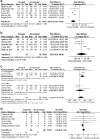The effects of a tourniquet used in total knee arthroplasty: a meta-analysis
- PMID: 24602486
- PMCID: PMC3973857
- DOI: 10.1186/1749-799X-9-13
The effects of a tourniquet used in total knee arthroplasty: a meta-analysis
Abstract
Background: The purpose of this research is to evaluate the effects of a tourniquet in total knee arthroplasty (TKA).
Methods: The study was done by randomized controlled trials (RCTs) on the effects of a tourniquet in TKA. All related articles which were published up to June 2013 from Medline, Embase, and Cochrane Central Register of Controlled Trails were identified. The methodological quality of the included studies was assessed by the Physiotherapy Evidence Database (PEDro) scale. The meta-analysis was performed using Cochrane RevMan software version 5.1.
Results: Thirteen RCTs that involved a total of 689 patients with 689 knees were included in the meta-analysis, which were divided into two groups. The tourniquet group included 351 knees and the non-tourniquet group included 338 knees. The meta-analysis showed that using a tourniquet in TKA could reduce intraoperative blood loss (weighted mean difference (WMD), -198.21; 95% confidence interval (CI), -279.82 to -116.60; P<0.01) but did not decrease the calculated blood loss (P=0.80), which indicates the actual blood loss. Although TKA with a tourniquet could save the operation time for 4.57 min compared to TKA without a tourniquet (WMD, -4.57; 95% CI, -7.59 to -1.56; P<0.01), it had no clinical significance. Meanwhile, the use of tourniquet could not reduce the possibility of blood transfusion (P>0.05). Postoperative knee range of motion (ROM) in tourniquet group was 10.41° less than that in the non-tourniquet group in early stage (≤ 10 days after surgery) (WMD, -10.41; 95% CI, -16.41 to -4.41; P<0.01). Moreover, the use of a tourniquet increased the risk of either thrombotic events (risk ratio (RR), 5.00; 95% CI, 1.31 to 19.10; P=0.02) or non-thrombotic complications (RR, 2.03; 95% CI, 1.12 to 3.67; P=0.02).
Conclusions: TKA without a tourniquet was superior to TKA with a tourniquet in thromboembolic events and the other related complications. There were no significant differences between the two groups in the actual blood loss. TKA with a tourniquet might hinder patients' early postoperative rehabilitation exercises.
Figures





Comment in
-
Evidence appraisal of Zhang W, Li N, Chen S, Tan Y, Al-Aidaros M, Chen L. The effects of a tourniquet used in total knee arthroplasty: a meta-analysis. J Orthop Surg Res. 2014;9(1):13. http://www.josr-online.com/content/9/1/13. Accessed May 30, 2014.AORN J. 2014 Aug;100(2):224-8. doi: 10.1016/j.aorn.2014.06.003. AORN J. 2014. PMID: 25219028 No abstract available.
References
-
- Berry DJ, Bozic KJ. Current practice patterns in primary hip and knee arthroplasty among members of the American association of hip and knee surgeons. J Arthroplasty. 2010;25(6 Suppl):2–4. - PubMed
-
- Burg A, Dudkiewicz I, Heller SS. The effects of using a tourniquet in total knee arthroplasty: a study of 77 patients. J Musculoskelet Res. 2009;12(3):137–142. doi: 10.1142/S0218957709002286. - DOI
Publication types
MeSH terms
LinkOut - more resources
Full Text Sources
Other Literature Sources
Medical

